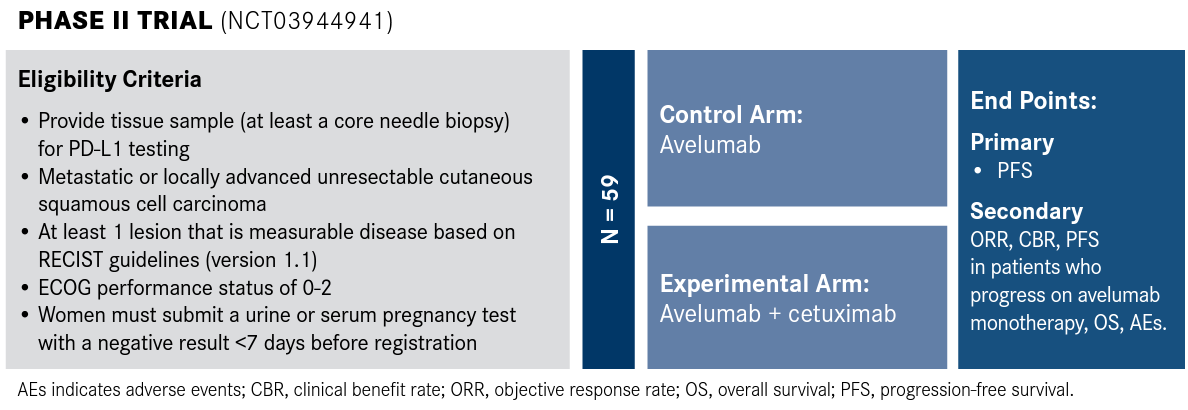Publication
Article
Oncology Live®
Study Tests Novel Doublet Designed to Promote Immunity in cSCC
Author(s):
Investigators are testing the hypothesis that administering cetuximab with an anti–PD-L1 agent will induce immunostimulatory synergy and prolong survival in patients with cutaneous squamous cell carcinoma.
Dan P. Zandberg, MD

Dan P. Zandberg, MD
Investigators are testing the hypothesis that administering cetuximab (Erbitux) with an anti—PD-L1 agent will induce immunostimulatory synergy and prolong survival in patients with cutaneous squamous cell carcinoma (cSCC).
The phase II Alliance A091802 trial (NCT03944941) will examine the combination of cetuximab and avelumab (Bavencio) versus avelumab monotherapy in approximately 59 patients with advanced cSCC to determine whether the doublet regimen will afford a survival advantage over the singleagent approach.
“The combination has significant potential because in addition to cetuximab’s direct targeting of cSCC, as an Ig [immunoglobulin] G1 monocloncal antibody [mAb], it also has the potential to induce antibody-dependent cell-mediated cytotoxicity [ADCC] and subsequent adaptive immunity, with preclinical data suggesting synergy between combination IgG1 monoclonal antibodies and agents that block the PD-1/ PD-L1 pathway. Using avelumab is of particular interest because avelumab also has the potential to induce ADCC,” said Dan P. Zandberg, MD, study chair of the Alliance A091802 trial and co-leader of the Head and Neck Cancer Program at the University of Pittsburgh Medical Center Hillman Cancer Center in Pennsylvania.
Avelumab is an anti—PD-L1 IgG1 isotype mAb. IgG1 mAbs are better able to stimulate ADCC, a process of defense in which immune cells identify and eradicate malignant cells, than other isotopes such as IgG2. IgG1 isotype mAbs can activate ADCC in the presence of natural killer cells, which lyse tumor cells, providing additional anticancer activity.1
Combining 2 ADCC-spurring mAbs may lead to the collaborative priming and activation of natural killer cells and thus, greater immunogenesis.1
Patients enrolled in Alliance A091802 will receive a maximum of 24 cycles of avelumab regardless of whether they are randomized to the single-agent control arm or the experimental arm. Those treated with the combination therapy will receive up to 12 cycles of cetuximab with avelumab followed by 12 additional cycles of singleagent avelumab. Patients in the avelumab monotherapy group who experience disease progression will be permitted to cross over to the other cohort to receive the doublet regimen.2
The primary end point is progression-free survival. Secondary end points include the objective response rate and the clinical benefit rate, among others (Figure). Of note, Alliance A091802 is open to patients with HIV. “Patients with HIV have traditionally been underrepresented in clinical trials, including in cSCC,” Zandberg said. “This trial includes these patients, which has not been done in prior immunotherapy trials in cSCC and most other solid tumor types.”
Expanding the cSCC Armamentarium
Figure. Avelumab With or Without Cetuximab in Advanced Skin Squamous Cell Cancer (Click to Enlarge)

The 2018 approval of cemiplimab-rwlc (Libtayo) for patients with metastatic or locally advanced cSCC who are not candidates for curative surgery or radiation was “a great step for this patient population,” said Zandberg.3
Cemiplimab-rwlc is the first and only treatment specifically approved for advanced cSCC and constitutes the standard of care.4 However, a wider portfolio of effective systemic options is needed both for locally advanced cSCC for which there is no surgical intervention and for metastatic disease.
Although cSCC is often effectively managed with radiation or surgical resection when diagnosed at an early stage, each year approximately 40,000 cases of cSCC progress to an advanced stage, when they are more difficult to treat.5 Outcomes among patients with recurrent or metastatic cSCC are typically poor, and an estimated 7000 patients in the United States die each year from cSCC.6 Data from large studies have associated a mortality rate of >70% with metastatic disease.7
cSCC is the second most common type of skin cancer.8 The disease is part of the nonmelanoma skin cancers, which, beyond cSCC, include basal cell carcinoma, Merkel cell carcinoma, and squamous cell carcinoma, according to Omid Hamid, MD, chief of Translational Research and Immunotherapy and director of Melanoma Therapeutics at The Angeles Clinic and Research Institute in Los Angeles, California.9 Ultraviolet light exposure, whether from the sun or from tanning beds, is known to significantly increases one’s risk for CSCC.8 Roughly 700,000 new cases are diagnosed each year and cSCC incidence is expected to rise between 2% and 4% each year until 2040.7
The development of more effective therapies to treat recurrent and metastatic cSCC will be critical as the malignancy is more widely diagnosed. Patients who experience disease progression on anti—PD-1/ PD-L1 regimens constitute a subgroup that is in need of additional treatment options, according to Zandberg.
Because the Alliance A091802 study will permit patients who experience disease progression on avelumab monotherapy to cross over to the cetuximab-avelumab arm, the trial “will evaluate, in an exploratory fashion, [the efficacy of] the combination therapy after failure of [an] anti—PD-1 mAb,” Zandberg said. “This has potential implications for cSCC as well as other malignancies” he added.
The Alliance A091802 study is currently recruiting across more than 300 locations nationwide.
References
- Ferris RL, Lenz HJ, Trotta AM, et al. Rationale for combination of therapeutic antibodies targeting tumor cells and immune checkpoint receptors: harnessing innate and adaptive immunity through IgG1 isotype immune effector stimulation. Cancer Treat Rev. 2018;63:48-60. doi: 10.1016/j.ctrv.2017.11.008.
- Patients with advanced cutaneous squamous cell carcinoma of the skin may benefit from new alliance trial teaming immunotherapy and monoclonal antibodies. Alliance for Clinical Trials in Oncology. allianceforclinicaltrialsinoncology.org/main/ public/standard.xhtml?path=/Public/News-A091802-Jul2019. Accessed February 27, 2020.
- Libtayo [prescribing information]. Eastview, NY: Regeneron Pharmaceuticals Inc; 2019. www.accessdata.fda.gov/drugsatfda_docs/ label/2019/761097s001lbl.pdf. Accessed February 27, 2020.
- FDA approves libtayo (cemiplimab-rwlc) as first and only treatment for advanced cutaneous squamous cell carcinoma [news release]. Tarrytown, NY: Regeneron Pharmaceuticals, Inc; September 28, 2018. investor.regeneron.com/news-releases/ news-release-details/fda-approves-libtayor-cemiplimab-rwlcf irst-and-only-treatment. Accessed March 10, 2020.
- Have you heard of cutaneous squamous cell carcinoma? Skin Cancer Foundation. skincancer.org/blog/ have-you-heard-of-cutaneous-squamous-cell-carcinoma/. Published July 26, 2019. Accessed March 10, 2020.
- What is advanced CSCC? Libtayo. libtayo.com/advanced-cscc. Accessed March 10, 2020.
- Burton KA, Ashack KA, Khachemoune A. Cutaneous squamous cell carcinoma: a review of high-risk and metastatic disease. Am J Clin Dermatol. 2016;17(5):491-508. doi: 10.1007/s40257-016-0207-3.
- Understanding cutaneous squamous cell carcinoma. Regeneron Pharmaceuticals. advancedcscc.com/-/media/EMS/Conditions/Oncology/Brands/Advanced-CSCC/pdf/CSCC-PatientFact-Sheet-32318.pdf?la=en. Accessed March 10, 2020.
- Overview of cutaneous squamous cell carcinoma. AJMC® website. ajmc.com/insights/emerging-agents-for-basal-cell-carcinoma-and-cutaneous-squamous-cell-carcinoma/ overview-of-cutaneous-squamous-cell-carcinoma. Published December 18, 2019. Accessed March 10, 2020.
Alliance A091802 investigators hope that combination cetuximab and avelumab will broaden the historically limited cSCC tool kit.










